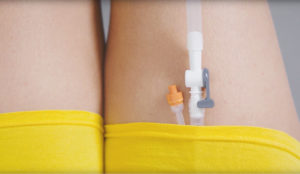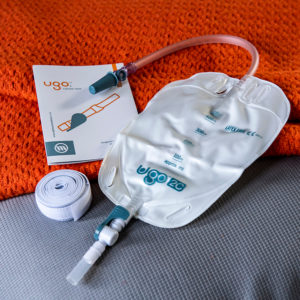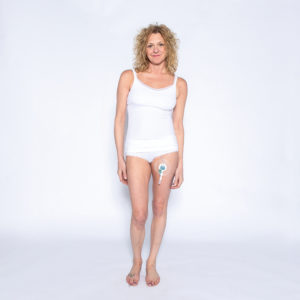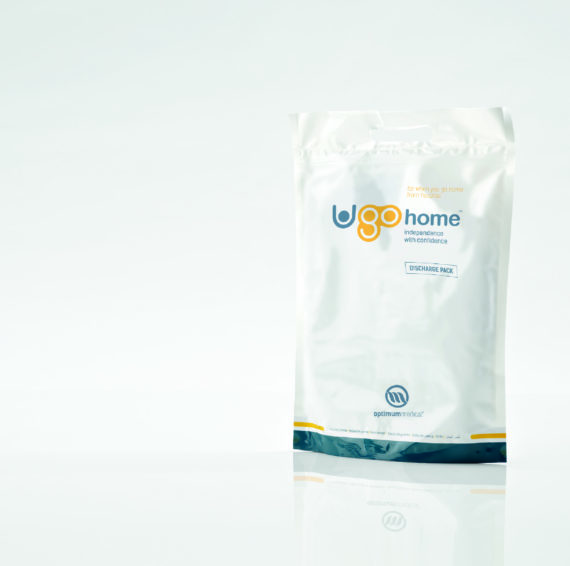Catheter drainage choices
The choice of whether to use a catheter leg bag or valve is an important decision for every catheter user, as both devices will have an impact on how the catheter is managed. Read on to discover the benefits of each device for catheter drainage and the reasons why one may be chosen one over the other.
If you’d like to receive FREE product samples, please complete the short form at the end of this blog post.
Catheter Valves
 What is a catheter valve and how does a catheter valve work?
What is a catheter valve and how does a catheter valve work?
A catheter valve attaches directly to the end of the catheter. It features a lever tap which, when opened, will allow the user to drain urine from their bladder. For people who are assessed as suitable to use a valve, it allows them the freedom of not having to wear a leg bag.
What are the advantages of using a catheter valve?
A catheter valve is used as an alternative to a catheter leg bag. However, unlike catheter bags, it supports the normal function of the bladder by allowing it to fill and drain intermittently. In some cases, a catheter valve can even be used to retrain an individual’s bladder ahead of a TWOC (trial without a catheter).
One of the main advantages of wearing a valve over a leg bag is the discreet nature of the small device. A catheter valve can be easily hidden under most types of clothing, giving the person with the catheter more freedom when deciding what to wear.
Using a catheter valve may also help reduce the risk of catheter blockage and infection.
Visit the Ugo Catheter Valve page on our website to find out more about our catheter valve.
Why may a catheter valve not be the right choice?
A catheter valve is not suitable for every catheter user and an assessment from a doctor or nurse is required beforehand. A catheter valve may not be suitable for catheter drainage if…
· The individual is unable to operate the valve lever
· They’re unable to remember to operate the valve
· They have limited bladder capacity
· They have reduced bladder sensation
· They’re renally impaired or have ureteric reflux
· They have an overactive bladder
Catheter Leg Bag
What is a catheter leg bag?
A catheter leg bag is designed to collect urine and be attached to either a urethral or suprapubic indwelling catheter. There are many variations of leg bags on the market and it’s important that an individual is able to use a bag which best suits them.
What are the different types of leg bags?
When it comes to urine drainage bags (also referred too as catheter bags) there are two main types of bag available, which are usually known as ‘leg bags’ for daytime use and ‘night bags’ for night-time use. There are also options for fabric-backed leg bags or non-fabric backed leg bags. Each box of fabric-backed Ugo Leg Bags includes a pair of velcro catheter leg straps, and they’re included in each individual pouch of non-fabric backed Ugo Leg Bags.
Leg bags which are used in the daytime are usually attached to the leg or thigh using fixation devices, such as leg bag straps or a leg bag sleeve. Usually leg bags can be hidden under clothes but you should wear your bag where it feels more comfortable and secure for you.
Generally, leg bags come in three different capacities – 350ml, 500ml, or 750ml. Most catheter or sheath users will usually be given a 500ml bag to start out with before trying smaller or larger sizes. It’s always important to remember that everyone is different. Some people may be better suited to a larger capacity 750ml, meaning they can go longer without changing the bag, whereas other people may prefer a smaller 350ml which may be concealed under clothing more easily but will also require changing more frequently.
If you are caring for a child who requires leg bags, some manufacturers offer specific leg bags for children which have a smaller capacity.
Leg bags also come with three different tube lengths; short tube (approx. 5cm), long tube (approx. 25cm) and direct inlet, which has no tube and attaches directly to the end of the catheter or sheath. Which tube length you should use is dependent on your preference and where you feel most comfortable wearing the leg bag on your body. If you’re unhappy with your current leg bag or would like to try something new you should speak with your continence nurse to discuss the best bag for you and your lifestyle.
At night-time, you can use a night bag (or 2L Drainage Bag) either attached directly to the end of your catheter or fitted to the end of your daytime leg bag to increase the capacity. These larger 2 litre night bags mean you don’t need to wake in the night to empty your bag.
What are the advantages of using a leg bag?
Leg bags are suitable for almost all indwelling catheter users to wear. When choosing the right leg bag, there’s a wealth of choice available, so the individual is almost certain to find a bag which suits their requirements.
Why may a catheter leg bag not be the right choice?
Unlike a valve, almost every catheter user will have the option to wear a leg bag, but should it be your first choice?
There are a few reasons why a catheter valve may not be suitable (see above) for catheter drainage, but if these contraindications aren’t applicable and an assessment to use a catheter valve has been completed by a doctor or nurse beforehand, then it might be worth giving a go!
Receive your FREE catheter drainage samples
Complete the form below to request your Ugo Urology samples:



